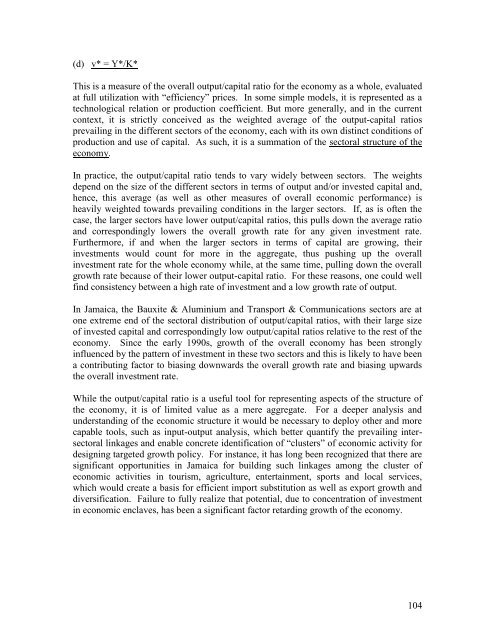PIOJ Growth-Inducement Strategy - Planning Institute of Jamaica
PIOJ Growth-Inducement Strategy - Planning Institute of Jamaica
PIOJ Growth-Inducement Strategy - Planning Institute of Jamaica
You also want an ePaper? Increase the reach of your titles
YUMPU automatically turns print PDFs into web optimized ePapers that Google loves.
(d) v* = Y*/K*<br />
This is a measure <strong>of</strong> the overall output/capital ratio for the economy as a whole, evaluated<br />
at full utilization with “efficiency” prices. In some simple models, it is represented as a<br />
technological relation or production coefficient. But more generally, and in the current<br />
context, it is strictly conceived as the weighted average <strong>of</strong> the output-capital ratios<br />
prevailing in the different sectors <strong>of</strong> the economy, each with its own distinct conditions <strong>of</strong><br />
production and use <strong>of</strong> capital. As such, it is a summation <strong>of</strong> the sectoral structure <strong>of</strong> the<br />
economy.<br />
In practice, the output/capital ratio tends to vary widely between sectors. The weights<br />
depend on the size <strong>of</strong> the different sectors in terms <strong>of</strong> output and/or invested capital and,<br />
hence, this average (as well as other measures <strong>of</strong> overall economic performance) is<br />
heavily weighted towards prevailing conditions in the larger sectors. If, as is <strong>of</strong>ten the<br />
case, the larger sectors have lower output/capital ratios, this pulls down the average ratio<br />
and correspondingly lowers the overall growth rate for any given investment rate.<br />
Furthermore, if and when the larger sectors in terms <strong>of</strong> capital are growing, their<br />
investments would count for more in the aggregate, thus pushing up the overall<br />
investment rate for the whole economy while, at the same time, pulling down the overall<br />
growth rate because <strong>of</strong> their lower output-capital ratio. For these reasons, one could well<br />
find consistency between a high rate <strong>of</strong> investment and a low growth rate <strong>of</strong> output.<br />
In <strong>Jamaica</strong>, the Bauxite & Aluminium and Transport & Communications sectors are at<br />
one extreme end <strong>of</strong> the sectoral distribution <strong>of</strong> output/capital ratios, with their large size<br />
<strong>of</strong> invested capital and correspondingly low output/capital ratios relative to the rest <strong>of</strong> the<br />
economy. Since the early 1990s, growth <strong>of</strong> the overall economy has been strongly<br />
influenced by the pattern <strong>of</strong> investment in these two sectors and this is likely to have been<br />
a contributing factor to biasing downwards the overall growth rate and biasing upwards<br />
the overall investment rate.<br />
While the output/capital ratio is a useful tool for representing aspects <strong>of</strong> the structure <strong>of</strong><br />
the economy, it is <strong>of</strong> limited value as a mere aggregate. For a deeper analysis and<br />
understanding <strong>of</strong> the economic structure it would be necessary to deploy other and more<br />
capable tools, such as input-output analysis, which better quantify the prevailing intersectoral<br />
linkages and enable concrete identification <strong>of</strong> “clusters” <strong>of</strong> economic activity for<br />
designing targeted growth policy. For instance, it has long been recognized that there are<br />
significant opportunities in <strong>Jamaica</strong> for building such linkages among the cluster <strong>of</strong><br />
economic activities in tourism, agriculture, entertainment, sports and local services,<br />
which would create a basis for efficient import substitution as well as export growth and<br />
diversification. Failure to fully realize that potential, due to concentration <strong>of</strong> investment<br />
in economic enclaves, has been a significant factor retarding growth <strong>of</strong> the economy.<br />
104
















